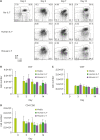Effect of Human or Mouse IL-7 on the Homeostasis of Porcine T Lymphocytes
- PMID: 34277114
- PMCID: PMC8263216
- DOI: 10.4110/in.2021.21.e24
Effect of Human or Mouse IL-7 on the Homeostasis of Porcine T Lymphocytes
Abstract
Due to the inconsistent fluctuation of blood supply for transfusion, much attention has been paid to the development of artificial blood using other animals. Although mini-pigs are candidate animals, contamination of mini-pig T cells in artificial blood may cause a major safety concern. Therefore, it is important to analyze the cross-reactivity of IL-7, the major survival factor for T lymphocytes, between human, mouse, and mini-pig. Thus, we compared the protein sequences of IL-7 and found that porcine IL-7 was evolutionarily different from human IL-7. We also observed that when porcine T cells were cultured with either human or mouse IL-7, these cells did not increase the survival or proliferation compared to negative controls. These results suggest that porcine T cells do not recognize human or mouse IL-7 as their survival factor.
Keywords: Graft-versus-host disease; IL-7; Miniature swine; T-lymphocytes.
Copyright © 2021. The Korean Association of Immunologists.
Conflict of interest statement
Conflict of Interest: The authors declare no potential conflicts of interest.
Figures





Similar articles
-
T cells from presensitized donors fail to cause graft-versus-host disease in a pig-to-mouse xenotransplantation model.Transplantation. 2004 Dec 15;78(11):1609-17. doi: 10.1097/01.tp.0000142621.52211.79. Transplantation. 2004. PMID: 15591949
-
Limited effect of recombinant porcine interleukin-12 on porcine lymphocytes due to a low level of IL-12 beta2 receptor.Vet Immunol Immunopathol. 2002 Oct 28;89(3-4):133-48. doi: 10.1016/s0165-2427(02)00205-2. Vet Immunol Immunopathol. 2002. PMID: 12383645
-
CD4+ and γδTCR+ T lymphocytes are sources of interleukin-17 in swine.Cytokine. 2012 May;58(2):152-7. doi: 10.1016/j.cyto.2012.01.004. Epub 2012 Feb 8. Cytokine. 2012. PMID: 22321808
-
Species specialization in cytokine biology: is interleukin-4 central to the T(H)1-T(H)2 paradigm in swine?Dev Comp Immunol. 2009 Mar;33(3):344-52. doi: 10.1016/j.dci.2008.06.014. Epub 2008 Aug 28. Dev Comp Immunol. 2009. PMID: 18761033 Review.
-
The International Xenotransplantation Association consensus statement on conditions for undertaking clinical trials of porcine islet products in type 1 diabetes--chapter 5: Strategies to prevent transmission of porcine endogenous retroviruses.Xenotransplantation. 2009 Jul-Aug;16(4):239-48. doi: 10.1111/j.1399-3089.2009.00544.x. Xenotransplantation. 2009. PMID: 19799764
Cited by
-
The Function of Memory CD8+ T Cells in Immunotherapy for Human Diseases.Immune Netw. 2023 Feb 23;23(1):e10. doi: 10.4110/in.2023.23.e10. eCollection 2023 Feb. Immune Netw. 2023. PMID: 36911798 Free PMC article. Review.
References
-
- Park CG, Kim JS, Shin JS, Kim YH, Kim SJ. Current status and future perspectives of xenotransplantation. J Korean Soc Transplant. 2009;23:203–213.
-
- Kim JH. Recent review on blood transfusion therapy. J Korean Med Assoc. 2013;56:496–503.
LinkOut - more resources
Full Text Sources

